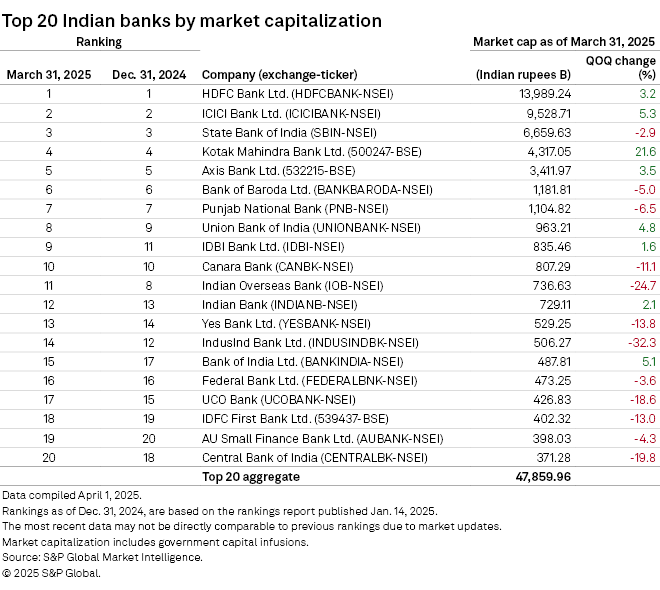S&P Global Offerings
Featured Topics
Featured Products
Events
S&P Global Offerings
Featured Topics
Featured Products
Events
S&P Global Offerings
Featured Topics
Featured Products
Events
Banking & Capital Markets
Economy & Finance
Energy Transition & Sustainability
Technology & Innovation
Podcasts & Newsletters
Banking & Capital Markets
Economy & Finance
Energy Transition & Sustainability
Technology & Innovation
Podcasts & Newsletters
S&P Global Offerings
Featured Topics
Featured Products
Events
07 Apr, 2025
By Ranina Sanglap and Marissa Ramos
Several of India's public-sector banks posted falls in their market capitalization in the first quarter of 2025, faring worse than their private-sector peers, as liquidity in the system gets a boost.
Seven of the 12 biggest banks that reported quarter-over-quarter declines in their market cap in the January-to-March period were state-owned, according to data compiled by S&P Global Market Intelligence. Indian Overseas Bank posted a 24.7% quarter-over-quarter fall in its market cap to 736.63 billion rupees. Central Bank of India shed 19.8%, the data show.

Liquidity shot
The Reserve Bank of India has pumped liquidity into the Indian banking system via a series of purchases of government securities under its open market operations in recent months. The central bank said on April 1 it will purchase 800 billion rupees in government securities over the month in four equal tranches, starting with 200 billion rupees on April 3. In March, it had pumped in 1 trillion rupees via purchases of government securities, plus a $10 billion rupee-dollar swap, for a total injection of more than $21 billion.
"The Reserve Bank will continue to monitor evolving liquidity and market conditions and take measures as appropriate to ensure orderly liquidity conditions," the central bank said in its April 1 statement.
The liquidity support is expected to benefit the private-sector lenders more as they are typically more leveraged, which allows them to extract better margins from their highly diversified lending portfolios.
Large private-sector lenders such as HDFC Bank Ltd. and Axis Bank Ltd. can gain from higher liquidity as the improvement would help their margins "quite significantly," Pranav Gundlapalle, senior research analyst at Sanford C Bernstein, told The Economic Times in a February interview.
Pack leaders
HDFC Bank retained its position as the biggest Indian bank, growing its market cap by 3.2% quarter over quarter to 13.989 trillion rupees. Kotak Mahindra Bank Ltd. posted the biggest improvement in its market cap, gaining 21.6% to 4.317 trillion rupees. Kotak Mahindra Bank's stock recovery could be linked to the central bank's February order to lift restrictions on onboarding new customers by the private-sector lender.
ICICI Bank Ltd. and Axis Bank were among the top five in the market cap ranking. ICICI Bank's market cap increased 5.3% to 9.529 trillion rupees and Axis Bank's was up 3.5% to 3.412 trillion rupees.
IndusInd Bank Ltd.posted the highest decline in market cap overall. The private-sector bank posted a 32.3% quarter-over-quarter decline in its market cap to 506.27 billion rupees after it disclosed in early March that it expects a 15.77 billion drop in net worth due to previously unreported accounting discrepancies.
State Bank of India, the country's biggest bank by assets, was the third-largest lender by market cap even as its capitalization fell 2.9% over the quarter to 6.660 trillion rupees. Three public sector banks – Union Bank of India, Indian Bank and Bank of India Ltd. – posted gains in their market cap during the first quarter, the data show.
As of April 7, US$1 was equivalent to 86.00 Indian rupees.
